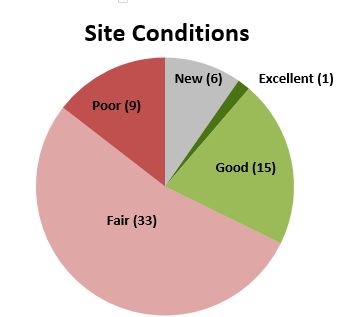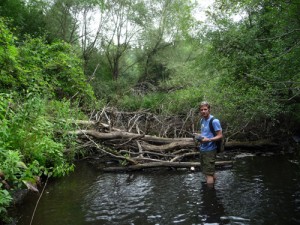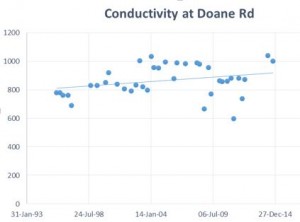Macroinvertebrate sampling on the Huron River and its creeks
Thanks to 128 volunteers who contributed approximately 650 volunteer hours, the October 2014 River Roundup was a great success! The weather was a little dreary and chilly for our volunteers as they split into 24 teams and traveled to 48 different creek and river locations across the Huron River Watershed to assess the aquatic benthic macroinvertebrate community. This study is one of the most effective ways that HRWC has to understand how the water quality of the river and creeks may be changing. From the data collected at this semi-annual event, we are able to keep abreast of the health of our waterways throughout the watershed. You can see all the results in October 14 River Roundup Report.
Also, in case you missed it, on November 13 the HRWC staff presented our data summaries of 2014 to a packed in crowd. Jason discussed the broadening of HRWC’s volunteers and volunteer programming. I walked through a case study showing how our data and volunteer programming can be used to investigate pollution problems, and Ric explained how box and whisker graphs can show us water quality data. For those who couldn’t make it, here’s a PDF of the presentation. Let us know if you have any questions!
Current Watershed Health
In a nutshell, the health of the watershed as judged by our macroinvertebrate sampling is holding steady. Of the 62 sites that we monitor to judge this, 28 sites have had no statistically significant changes over time, and 6 sites are too new to make this judgment.
Fourteen sites are declining, and these include locations on Chilson Creek, Davis Creek, east branch of Fleming Creek, Norton Creek, and South Ore Creek. Eight of the declining sites are in Livingston County, two are in Washtenaw, and three are in Oakland.
Fourteen sites are significantly improving. Twelve of the improving sites are in Washtenaw County, including Boyden Creek, Horseshoe Creek, the main and west branches of Fleming Creek, Huron Creek, the Huron River in Ann Arbor and Ypsilanti, Malletts Creek, and several places on Mill Creek. One site is improving in Livingston County (Mann Creek at Van Amberg Road), and 1 site is improving in Wayne County (Woods Creek at the Lower Huron Metropark).
Highlight
I’ve become a big fan of Arms Creek over the couple of years as I have learned more and more about it. While possessing a rather mucky stream bed, the water is cold and heavily influenced by groundwater, the riparian zone is thick and undisturbed in many parts, and there is plenty of woody debris in the water. In fact, part of Arms Creek is actually in a Natural River Zone. Also, many many years ago, the DNR stocked trout in Arms Creek because of the cold water temperature, which is a very rare thing for southeast Michigan. However, despite all of these great properties, the insect community has only ever been mediocre (probably due to the fine sand and muck dominating the streambed).

Therefore I was very excited to see this fall’s sample was the best ever collected there since sampling started in 1994. Sixteen total insect families were found, with five of those members of the mayfly and caddisfly families, and 3 of the families classified as “sensitive”. Sensitive families are those that are first to disappear in disturbed or polluted conditions. Finding three sensitive families is very good and usually only our best River Roundup sites have that many.
Lowlight
I have lowlighted Davis Creek before in this results blog, but the really poor results from this Roundup have prompted me to look into the issue again. Both the Doane Road and Pontiac Trail sites had very poor macroinvertebrate samples; the worst seen in many years at both of these sites. Both of these sites are on the main branch of Davis Creek, upstream from Sandy Bottom and Ten Mile Lake, on the outskirts of South Lyon.
To investigate the issue, I looked at the habitat data collected by our volunteers in the summer. Both locations have good to excellent habitat, with good diversity of substrate, good riparian zones, and plenty of instream woody debris. Furthermore, summer creekwalkers also explored two sections of this creek and also reported finding good habitat throughout.
Therefore, it is probable that there is something dissolved in the water, rather than poor habitat, that is reducing the macroinvertebrate diversity and abundance. Our volunteers regularly take water samples during the River Roundup that we analyze for conductivity (a proxy for total dissolved solids, which includes inorganic or organic substances, naturally found and pollutants). I plotted out conductivity over time and did indeed notice an increase of conductivity since 1994. Conductivity is going up; bugs are going down. A correlation like this does not prove anything especially given the variability in the data, but it is an interesting clue.

As a followup, it could be useful to get a water analysis to determine the exact chemical constituents of Davis Creek. We may be dealing with herbicides or pesticides, or perhaps excessive chloride (from water softeners). There is also more of the creek to explore on foot, as there are some light industrial and residential areas that we have not visited yet.
What’s next?
Do you consider yourself a Michigander, or aspire to be one? Then you should brave the cold and join the Winter Stonefly Search on January 17. It is like the River Roundup, only much snowier. You can register for the event here.



